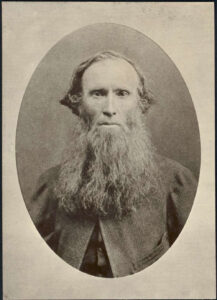
Charles Harpur was Australia’s first significant native-born poet and has been described as “The father of Australian poetry”.[1] He has often been credited as the first native-born poet to have had his works published in Australia, although that distinction actually belongs to Charles Tompson; however, Harpur was Australia’s first poet of consequence, and is still highly-regarded in modern times.
Harpur was born in Windsor, New South Wales, on 23 January 1813. His father was from County Cork, Ireland, and his mother from Somerset, England, both of whom had been sent out to Australia as convicts.
In a time without the modern benefits of free public education and free public libraries, Charles was lucky that his father was close friends with John Macarthur, Governor Lachlan Macquarie, and the Reverend Samuel Marsden, as he was able to visit their private libraries, which, along with the support of his father, enabled him to gain an education that someone in his position would not normally acquire.
His biographer, James Normington-Rawling (author of Charles Harpur, an Australian), wrote that Harpur had early on decided that his mission in life was that of a poet and he therefore ignored the pursuit of money, thus enabling him to concentrate on his writing. He took on various mundane jobs to sustain himself, but became a teacher after he was married in 1850 to Mary Doyle. He lasted a year in his teaching position, but left that to do sheep farming; this move may have been made to enable him to concentrate on his writing again, and was possibly due to the influence of Daniel Deniehy and other writers whom he had met in Sydney. However, he later took on a job as an assistant gold commissioner, which lasted from 1859 to 1866.
His writings were widely published, with his poetry appearing in many newspapers, along with articles that expressed his support for the right to vote, colonial self-government, republicanism, and an end to the transportation of convicts. His works were well-regarded, and he was in contact with many others in the Australian literary scene, such as John Le Gay Brereton, Daniel Deniehy, Henry Kendall, James Norton, and Henry Parkes.
The Cambridge History of English and American Literature says that “Charles Harpur may be considered the first distinctively Australian poet. . . . He was the first Australian poet to give a worthy imaginative representation of Australian scenery and nature.”[2]
Harpur died of tuberculosis in Eurobodalla, New South Wales, on 10 June 1868. He was survived by his wife, two daughters, and two sons (a third son had died in March 1867 in an accident, a grievous blow which may have contributed to Harpur’s poor state of health).
His wife collected his poetry for publication and the volume Poems was published in 1883; however, many of the poems were so heavily edited by the book’s editor, H.M. Martin, that it is not regarded as the best representation of his work.[3] A massive collection of his poems (including manuscript poetry), The Poetical Works of Charles Harpur, was published in 1983.
References:
[1] “The Late Mr. Charles Harpur”, The Sydney Morning Herald (Sydney, NSW), 7 July 1868, page 5
[2] “XII. The Literature of Australia and New Zealand.§ 1. Charles Harpur” [The Cambridge History of English and American Literature in 18 Volumes (1907–21). Volume XIV. The Victorian Age, Part Two], Bartleby.com
[3] J. Normington-Rawling. “Harpur, Charles (1813–1868)”, Australian Dictionary of Biography, National Centre of Biography, Australian National University
Further information:
“Charles Harpur”, Wikipedia (accessed 15 October 2012)
“Harpur, Charles”, AustLit
The portrait photo of Charles Harpur included in this article has been digitally enhanced, so as to restore it to a state closer to its original condition. The unaltered image was sourced from Trove (National Library of Australia).
Graphic source:
“Portrait of Charles Harpur, poet [picture]”, Trove
Leave a Reply